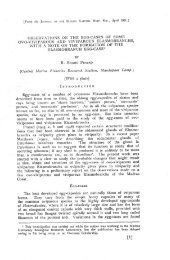PDF - Eprints@CMFRI
PDF - Eprints@CMFRI
PDF - Eprints@CMFRI
You also want an ePaper? Increase the reach of your titles
YUMPU automatically turns print PDFs into web optimized ePapers that Google loves.
124<br />
1892. ORTMANN. 660.<br />
pacbychila 1879. KLUNZ1NGER 3. IS ; pI. 1/6.<br />
Platygyra rustica 1936 •. WELLS. 104.<br />
1967. SCHEER, 432.<br />
1971 . LOVA & SLOBODK1N. 134.<br />
Cae/oria subde ntata 1857. MILNE EDWARDS (& HAIME). 413.<br />
P/alygyru subdentata 1971 , LOVA & SlOBODKIN, 124.<br />
We have a large number of specimens from Red Sea that we place under this species. Instead of trying<br />
to describe individual specimens we give below the major skeletal variations displayed.<br />
Length and depth of valleys: Rarely monostomodaeal, length 1 to \0 em, straight or<br />
sinuous. Width 5 to 7 mm , depth 5 to 8 mm. Interrupted or extending from one edge to other of the<br />
corallum .<br />
CoIl i n e s: Mostly acute at the top, perforated, getting thicker (2 mm) towards the base, In some<br />
coralla the rop of collines a little thickened a nd less perforated.<br />
S e pt a: Generally steep at the wall , only slightly exserr, o nly slightly broader below than at the top;<br />
alternating in size; edges dentate, the last rooth the largest. Septal sides granular. Exserr part arched or<br />
vertical, maximum exserrness l.5 mm .<br />
Col u m e II a: Trabecular, continuous. In some cases columella not visible, the bottom of the valleys<br />
being filled with endothecal vesicles. In many cases the columella is highly thickened and looks lamellar.<br />
Then the collines are also thickened , obtuse at the top and little perforated, thus simulating Leploria<br />
condition.<br />
Material:<br />
Gulf of Suez:<br />
Gulf of Aqaba:<br />
orthern R. S. :<br />
Jerus. SLR<br />
T. Aviv NS<br />
Jerus. SLR<br />
T . Aviv NS<br />
Basel<br />
HLM<br />
T. Aviv<br />
USNM<br />
HLM<br />
PW<br />
EC<br />
NS<br />
Wa<br />
X2:<br />
EC<br />
1809 (Abu Durba); 831 (Et Tur).<br />
1904, 5888 (Et Tur) ; 8438 (Ras el Kanisa).<br />
371, 386 (Marsa Murach); 458-1- 3 (E I Kura).<br />
269, 292,294, 1263, E4711, 4, E55 / 548h (Eilat); 1914(MarsaMurach);<br />
4895 (Wassit); 4941 , 4955 , 4993 , 4995 (Dahab ); 4810, 4812, 4816,<br />
4830,4832,4871 , 4879 (Ras Atanwr).<br />
73692 (Dahab).<br />
462 (Eilat ).<br />
3198 (Ras Muhammad).<br />
7 1, 72 (Ghardaqa).<br />
3- 8,14,20, 21 , 26, 37 , 43 (Gubal lsl.).<br />
484 (Ras Abu Suma); 500 (Safaga Is\.); 72 ( Koseir, duplicate from<br />
KLUNZINGER as Coeloria arabica) ; 311 , 312 (Ras Abu Hagar).<br />
34, 40, 41 , 42 (Sanganeb R.).<br />
33, 33a, 34, 35 , 35a, 37, 37a, 38 , 38a, 39, 39a, 92 , 119 (Wingate R.).<br />
9- 14, 15 ,22,29, 30 (Sarso Isl.).<br />
Central R. S.: P. Sud. Sa<br />
HLM RM<br />
Southern R. S.: HLM X2 :<br />
EC 399-402 (Massawa).<br />
Di s t r ib uti 0 n : Widely distributed from Red Sea into the Pacific as far east as Samoa and Cook IsIs.<br />
Rem ark s: The nomenclatural history of this species is lengthy, a resume of it is given by CHEVALIER<br />
(1975). MATIHAI (1928) in his monograph kept Coeloria daedalea and C. ia77leliina separate. WELLS<br />
(1936: 104) stated that the name daedalea ELLIS & SOLANDER is preoccupied by FORSKAL'sMadrepora<br />
daedalea which is Alveopora daedalea, and hence not available to Platygyra. He proposed the next available<br />
name Meandrina rustica DANA . However, CROSSLAND (1952 : 148) argued vehemently against such<br />
changes of nomenclature and adopted the specific name daedalea to Coeloria ruslica, from which he<br />
separated Coeloria lamellina as the more abundant species in the Red Sea. In 1956 STEPHENSON and<br />
WELLS merged Platygyra lamellina and daedalea rogether with TUstica , sinensis and other species and<br />
adopted the specific name lamellina of EHRENBERG.<br />
Recently WljSMAN-BEST ( 1972 and 1976) and VERO ,PICHO & WljSMAN-BEST (1977) followed<br />
MATIHAI (1928) and separated again P. lamellina from P. daedalea, though CHEVALIER (1975) felt they<br />
are one and the same with the name daedalea.<br />
In two earlier communications the present authors (SCHEER & PILLAI 1974 and PILLAI & SCHEER<br />
1976) followed STEPHENSON and WELLS and named the species as lamellina. But we made no attempt
















